|
What's a pantry pest? They are a group of insects that thrive off of stored food products, especially flour, cereal, pasta, crackers, breads, corn starch, seeds, nuts, dried fruit and pet food. As a result, infestations by these insects normally occur in your pantry. Pantry pests thrive at room temperature (between 20 and 30 C), however, they cannot function at refrigeration temperatures. These insects are the sworn enemy of farmers and food manufacturers of grain products. These pesky invaders normally enter your home through contaminated food products. Here is a list of some common
pantry pests:
|
|
|
|
|
|
Cabinet Beetle
This beetle is small and rounded, which makes it easy to confuse with other small round beetles. It can also be referred to as a khapra or warehouse beetle. Like other pantry pests, it prospers dry storage places that contain grain products. The cabinet beetle and its larva (shown right) are very resistant to high temperatures. The lifecycle of a cabinet beetle can be as long as 3 or 4 months. During this time they feed, pupate, mate, and lay eggs. The speed of their lifecycle is highly dependent on the temperature and quantity of food available. This fact keeps household infestations limited to a few rooms. Traps using pheromones may be set to control the outbreak.
|
|
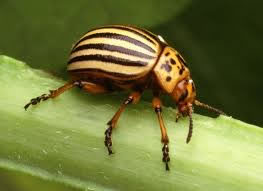 |
|
|
|
|
|
|
|
Flat Grain Beetle
This beetle has a flattened reddish brown colored body that is 1.5 to 2 mm long. The unique characteristic of the flat grain beetle are the long antennae. This beetle is easily confused with the rusty grain beetle and the flour mill beetle. These beetles achieve maximum reproduction when temperatures are between 17.5 and 37.5 C and with a relative humidity of over 50%. The flat grain beetle does not require grain to be damaged nor do they require small particulate materials to survive. Evidence of a flat grain beetle infestation in grain stores can be observed as tiny pin holes in the germ (outer protective shell) of the grain.
|
|
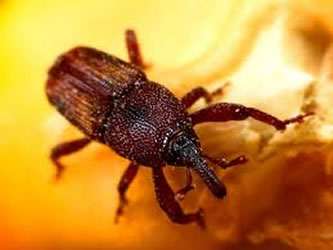 |
|
|
|
|
|
|
| |
Grain Borer
This beetle is a dark reddish-brown color and has a body length of approximately 3 mm. The antennae are its characteristic features as they have three distinct segments. The grain borer is one of the most destructive beetles known to attack grain stores. It consumes the germ and endosperm of grain kernels, reducing them to a shell with a distinctive hole. The grain borer's diet is not restricted to grain products but also includes cereals, seeds, dried fruit, drugs, cork, wood, and paper products. Optimal breeding conditions are between 20 and 34 C with 14% relative humidity. The grain borer may have a lifespan of up to 240 days.
|
|
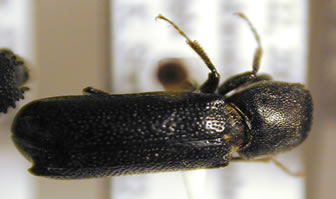 |
|
|
|
|
|
|
|
Granary Weevil
This beetle has a polished chestnut brown or blackish body color that is approximately 5 mm long. The characteristic feature of granary weevil is the long snout, however, it can be difficult to tell apart from the rice weevil. The granary weevil feeds on grain kernels and leave only the shells. The damage caused by the granary weevil often prepares the food stores for further insect infestation due to the increased number of damaged kernels. The adult beetles are unable to fly. The typical lifespan is between 7 to 8 months. The female granary weevil drills a hole in a kernel to lay its eggs inside, which is subsequently sealed. The female beetle will lay up to 150 eggs in the same number of grain kernels. The granary weevil is very resilient to a wide range of temperatures, 15 to 30+ C.
|
|
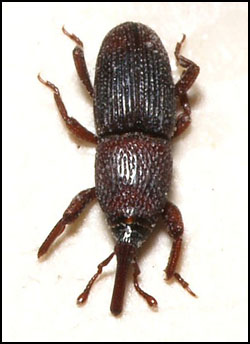 |
|
|
|
|
|
|
|
Rice Weevil
This beetle has a dark brown body that is between 2.5 and 4 mm long. The characteristic feature of the rice weevil is their long snout, however, it can be difficult to tell apart from other species of weevil. The rice weevil feeds on the inside of grain kernels and leave only the shells with a significant hole. The damage caused by the rice weevil often prepares the food stores for further insect infestation due to the increased number of damaged kernels. The adult beetles are unable to fly. The typical lifespan is between 4 to 12 months. The female rice weevil drills a hole in a kernel to lay its eggs inside, which is subsequently sealed. The female beetle will lay up to 150 eggs in the same number of grain kernels. The rice weevil is very resilient to a wide range of temperatures, 15 to 34 C.
|
|
 |
|
|
|
|
|
|
|
Red Flour Beetle
The red flour beetle is a common pantry pest. This pest is well known to operators of flour mills. As a result, the red flour beetle invades our homes mostly through contaminated flour. The red flour beetle has a reddish-brown in colored body that is usually about 4 mm long. The red flour beetle is often mistaken for the confused flour beetle. The food of choice for this pantry pest is usually stored grains, oilseeds, and products derived from them. This beetle is most likely to feed on damaged grain; however, it will feed on whole wheat if necessary. The red flour beetle thrives in environmental conditions between 20 and 40 C. The red flour beetle has become entrenched in Canada as it is able to survive the winter if it find a protected dwelling.
|
|
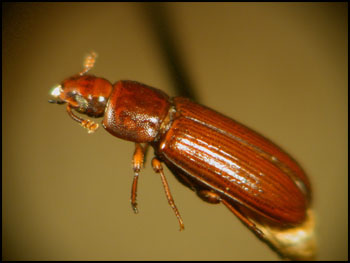 |
|
|
|
|
|
|
|
Sawtoothed Grain Beetle
The sawtoothed grain beetle has a brown body that is approximately 3 mm long. It is flattened and slender in shape. they are easily identified by the "saw" shaped protrusions just below its head on its thorax (see image to the left). As you might have guessed, this is where the sawtoothed grain beetle's name is derived. These beetles prosper in an environment with temperatures between 17 and 37 C. A female can lay up to 400 eggs in its lifetime. These eggs are laid either loosely in milled grains or in damaged grain kernels. Despite the threatening sounding name, the sawtoothed grain beetle does not normally feed on whole kernels. This beetle prefers milled products including breads, cereals, and pastas.
|
|
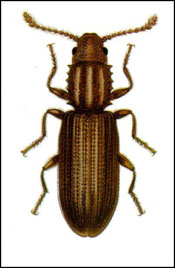 |

